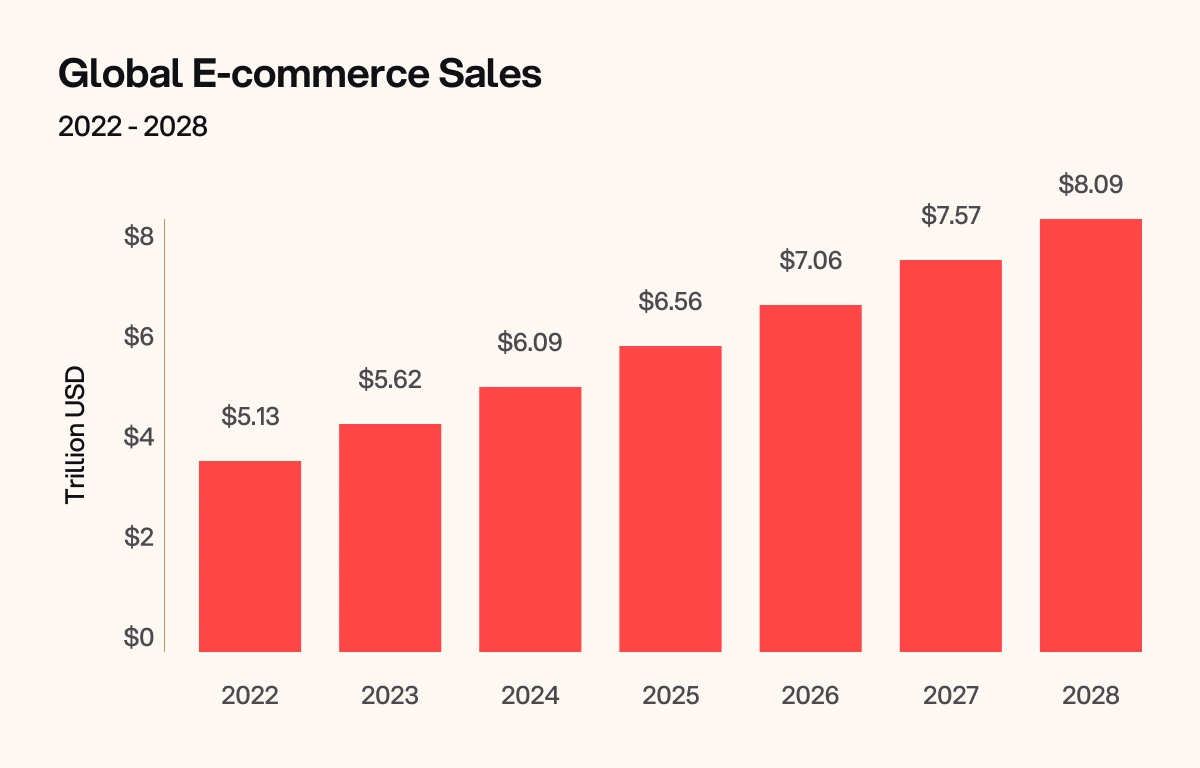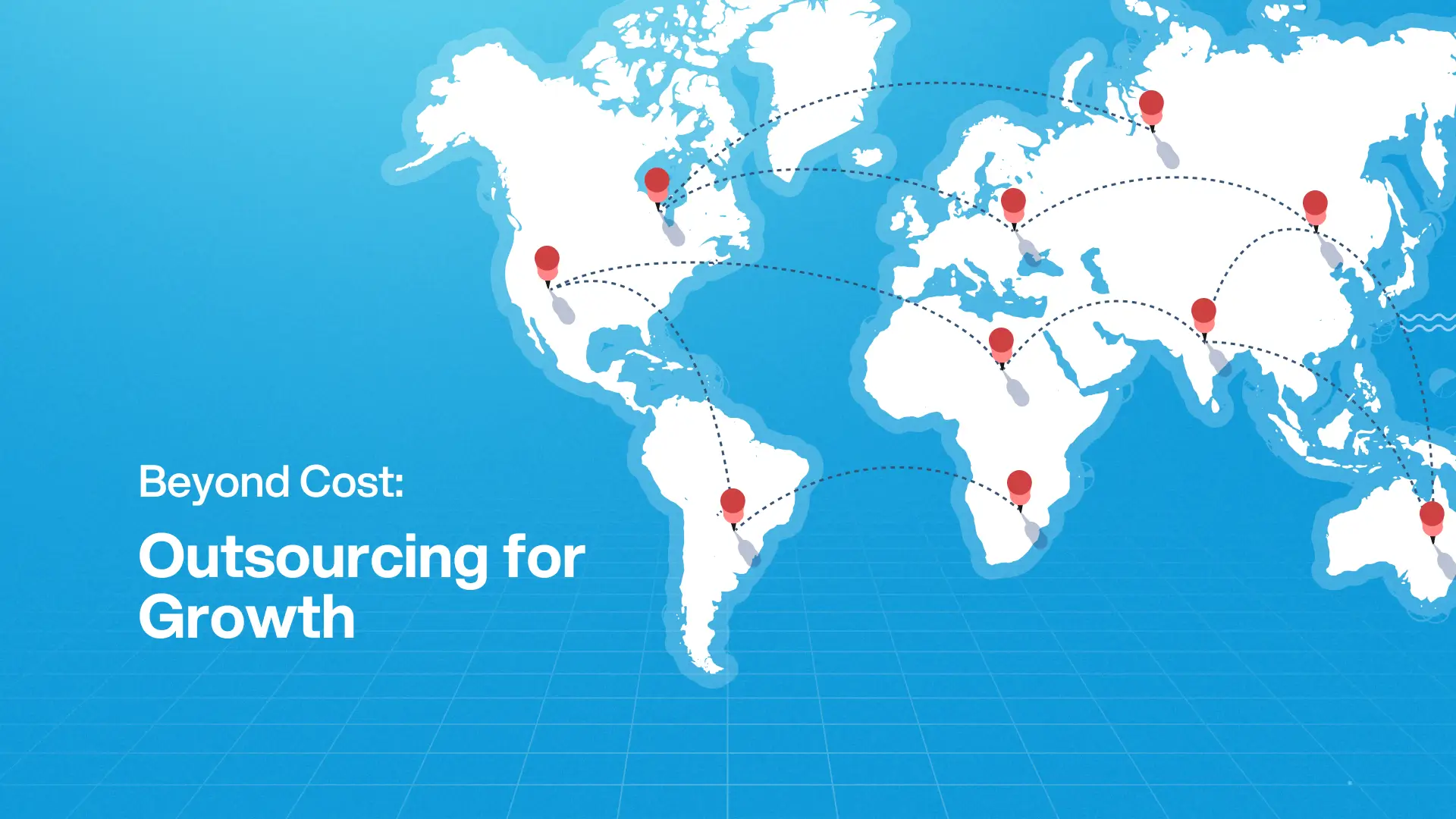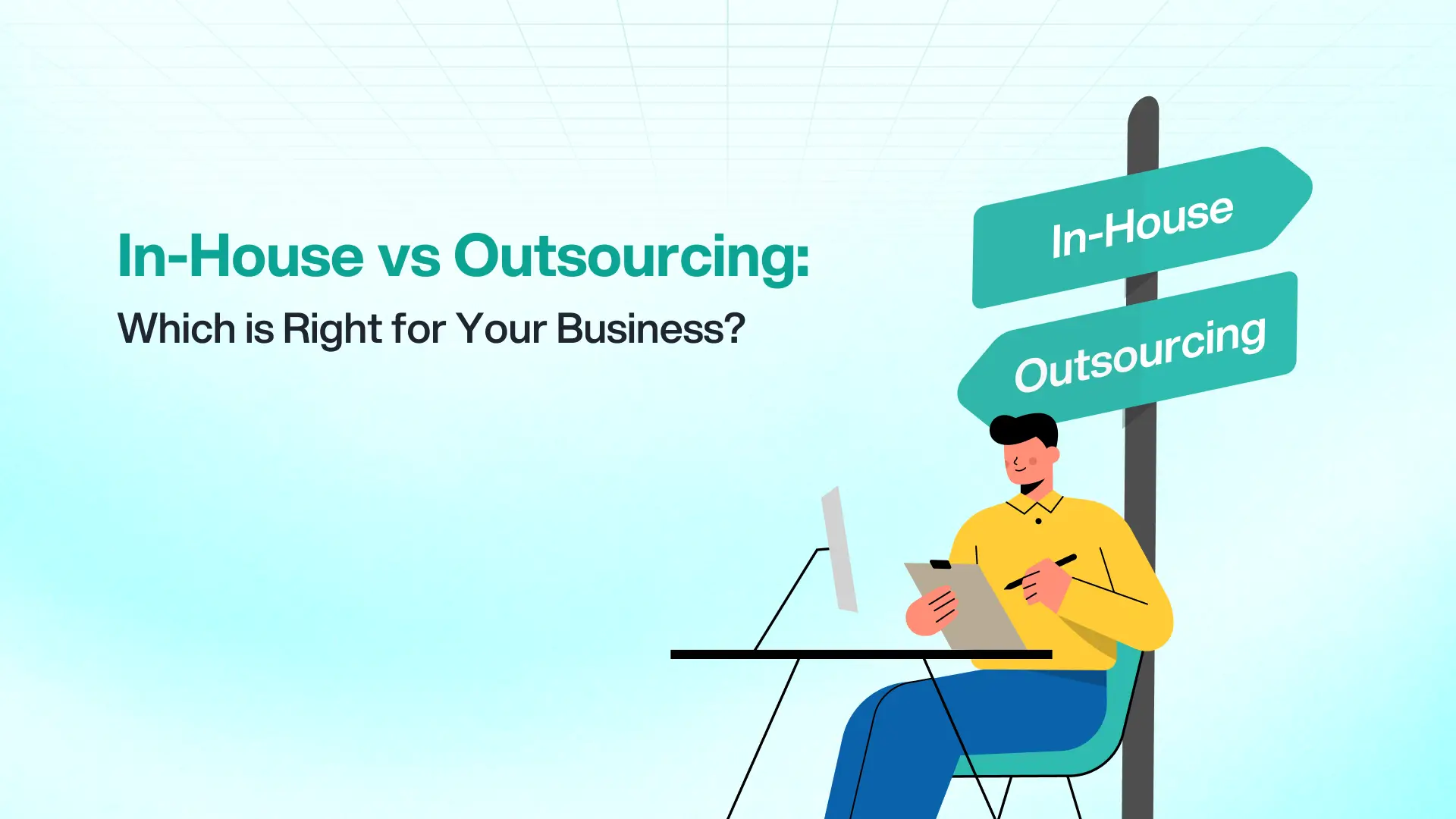Post Activity
 269
269
Table of Content
Share This Post
Table of Content
E-commerce growth is outpacing infrastructure in many companies, leading to slowdowns, outages, and lost revenue during peak demand. For CTOs and engineering leaders, scalable web architecture is the foundation for avoiding these failures and enabling continuous performance under real-world pressures like flash sales, international expansion, or product launches.
A scalable architecture allows your platform to process high volumes of traffic, transactions, and data without degradation. It uses vertical and horizontal scaling to deliver speed, reliability, and flexibility. This makes your system not just operationally sound, but strategically positioned for fast deployment, regional growth, and real-time personalization.
Scalable Web Architecture Fuels Business Growth for E-commerce
Shopify estimates world retail e-commerce sales will reach $8.09 trillion by 2028. Scalability is a core survival factor in the current digital economy. It directly impacts the ability to handle growth, maintain performance, and stay competitive.

Scalable architecture transforms e-commerce from a fragile cost center into a resilient growth engine. It empowers your team to deliver high performance at any scale, reduce technical debt, and stay ahead of both customer expectations and competitive threats. Scalability is not just a technical safeguard. It is also a growth enabler.
Here’s how:
1. Expanding Your Customer Base
As your brand gains traction, traffic volumes and user interactions scale exponentially. In response to that, a scalable system supports growth into new regions, product lines, and verticals, without costly overhauls. A non-scalable platform becomes a bottleneck.
2. Enhancing Customer Experience
Modern shoppers expect pages to load in under two seconds, seamless checkout flows, and 24/7 uptime. Scalable architectures ensure that even during high-load events (flash sales, holidays), your site performs with consistency. This leads to higher conversion rates and customer loyalty.

According to Neil Patel, 47% of consumers expect pages to load in two seconds or less. This makes fast load times critical for E-commerce sites. Slow load times negatively affect satisfaction and conversion rates.
3. Future-Proofing Your Business
Investing in scalable infrastructure not only addresses current traffic needs but also prepares for future growth. This investment allows businesses to seize new opportunities and deliver exceptional customer experiences. Additionally, investing in scalable infrastructure can lead to significant cost savings through automation and optimization of resource usage.
As technologies evolve, a well-architected, scalable system allows you to integrate new services and adapt without re-architecting from scratch. This gives your business long-term flexibility and resilience. Cloud-native scalable systems (e.g., AWS/GCP/Azure) let you auto-scale resources based on real-time demand, which minimizes waste and optimizing spend. You don’t need to over-provision infrastructure to prepare for peak traffic anymore.
Thinking of Outsourcing?
Access a wide range of outsourcing companies and find your best fit.
Scalability Is a Priority for Modern E-commerce Websites
1. Surge in Traffic
E-commerce platforms often face unpredictable spikes in traffic, like during sales or holidays. Scalable systems can handle increased user loads without crashing or slowing down, ensuring a seamless customer experience.
Companies like Amazon and Alibaba heavily invest in scalable infrastructure to manage traffic during major events. For example, Alibaba’s system can process over 544,000 orders per second during peak times, highlighting the importance of scalability.
2. The Need for Speed
In e-commerce, speed wins. Whether launching new features, expanding internationally, or adapting to seasonal demand, a scalable architecture enables your engineering teams to pivot quickly, deploy updates faster, and seize opportunities ahead of slower competitors. According to a Deloitte report, even a 100ms improvement in mobile response time can lead to an 8% increase in conversion rate. Modern shoppers demand fast load times, smooth navigation, and reliable transactions. Scalable infrastructure supports consistent performance, reducing cart abandonment and boosting satisfaction.
3. Competition
In this digital economy, performance itself is a product. In a crowded market, downtime or slow performance can drive customers to competitors. Scalability ensures reliability, helping retain customers and maintain brand reputation.
4. Data and Analytics
E-commerce relies on data for personalization, inventory, and marketing. Scalable systems manage growing data volumes, enabling real-time insights without performance bottlenecks.
5. Global Reach
Expanding to new regions means handling diverse customer bases, currencies, and regulations. Scalable platforms support this complexity while maintaining performance across geographies.
Ready to Build Your Team?
Let’s create together, innovate together, and achieve excellence together. Your vision, our team – the perfect match awaits.
Case Study: Mercado Libre’s Journey to Scalable E-commerce
Mercado Libre, headquartered in Argentina, is the largest online commerce and payments provider in Latin America. The e-commerce platform faced immense scalability challenges as it expanded to serve over 80 million active users across 18 countries. With rising transaction volumes, marketplace complexity, and rapid business growth, its legacy infrastructure began to strain. This led to performance bottlenecks, operational inefficiencies, and risks to customer experience.
To address these pain points, Mercado Libre embarked on a strategic migration to Amazon Web Services (AWS). It re-architected its platform using a microservices-first approach and adopted serverless technologies like AWS Lambda, Amazon DynamoDB, and Amazon Kinesis to process real-time data at scale. The company also deployed Amazon GuardDuty and AWS WAF for robust, cloud-native security. By modernizing its architecture:
- It achieved high elasticity to handle traffic spikes during major events (e.g., Black Friday).
- Reduced latency and improved performance across a highly distributed user base.
- Supported millions of secure transactions per day without degradation.
- Gained real-time analytics for faster decision-making and personalization.
This transformation positioned Mercado Libre as a benchmark for scalable, resilient e-commerce architecture in emerging markets. This case proves how cloud-native modernization fuels sustainable growth.
The Evolution of E-commerce Architecture: From Monolithic to Microservices
E-commerce architecture has undergone a significant transformation over the past decade. It evolved from monolithic systems to microservices-based architectures. The demand for enhanced scalability, flexibility, and resilience in today’s intricate and high-traffic online commerce landscapes is the driving force behind this transformation.
Monolithic Architecture: The Traditional Approach
In a monolithic architecture, all components, such as the user interface, business logic, and data access layer, are tightly integrated into a single codebase and often share a single database. While this approach simplifies initial development and deployment, it becomes a bottleneck as the business grows. Scaling specific functionalities (like checkout or inventory) requires scaling the entire application, leading to inefficiencies and higher costs. Making changes or introducing new features is risky and time-consuming, as a single bug or failure can potentially bring down the entire platform.
Transition to Microservices Architecture
The limitations of monolithic systems have driven e-commerce businesses to adopt microservices. Microservices architecture decomposes the e-commerce platform into independent, self-contained services, each responsible for a specific business function (e.g., order processing, payments, inventory management). These services communicate via APIs, allowing them to be developed, deployed, and scaled independently. The migration process typically involves identifying key business functions, separating them into distinct services, and ensuring smooth API-based communication between them.
Advantages of Microservices for E-commerce
The comparison table below shows why more companies are leaning towards a microservices architecture:
The evolution from monolithic to microservices architecture has revolutionized e-commerce platforms, enabling them to meet the demands of modern digital commerce. Microservices provide scalability, flexibility, resilience, and agility, the key advantages that allow e-commerce businesses to innovate rapidly, deliver superior customer experiences, and stay competitive in a dynamic market.
Scalable Web Architecture Enhances User Experience in E-commerce
Scalable architecture significantly enhances user experience in e-commerce by ensuring the platform performs reliably and responsively under varying and often unpredictable traffic loads. E-commerce platforms often face sudden surges in traffic during sales, holidays, or product launches. A scalable architecture, especially one based on microservices, allows individual services (like shopping cart, checkout, or product catalog) to scale independently to meet demand without slowing down or crashing the entire platform. This prevents slow page loads, timeouts, or outages that frustrate users.
Scalable architectures enable the deployment of specialized services for different regions, languages, or customer segments. This flexibility allows e-commerce platforms to tailor experiences, such as payment options or product recommendations, enhancing user engagement and satisfaction globally.
Scalable Web Architecture Is a Strategic Asset and a Growth Enabler
Scalability is critical for your e-commerce business. The architecture of your platform is no longer just a support system; it’s a business lever that determines how fast you can grow, how reliably you can operate, and how well you can serve increasingly demanding customers. Your site should be ready for 100x traffic surges, global demand, and new feature rollouts. If your architecture doesn’t scale, your growth will fall.
A scalable architecture safeguards your revenue and reduces technical debt.
The table below explains how to use a scalable web architecture for better performance:
By embedding scalability into your technology strategy, you empower your engineering teams to build with confidence, ship faster, and scale globally, without technical friction. For growth-stage and enterprise e-commerce companies alike, it’s one of the smartest long-term investments you can make.
Conclusion
Scalable web architecture is essential for e-commerce businesses that want to move fast, scale globally, and deliver consistently high performance. It enables your platform to handle traffic surges, roll out features quickly, and adapt to changing market demands without disruption. It is a long-term investment in resilience, agility, and growth. To stay competitive and customer-focused, scalability must be treated as a strategic priority and not a one-time infrastructure decision.
Find Your Perfect Software Outsourcing Partner
Unlock a world of trusted software outsourcing companies and elevate your business operations seamlessly.






